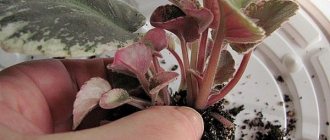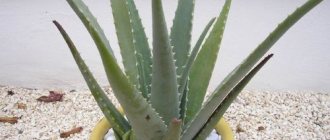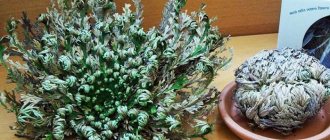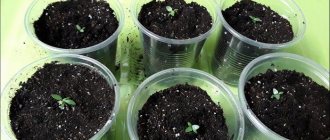As soon as one violet appears on your windowsill, you will certainly want to transform your entire apartment by decorating it with these wonderful flowers. It is difficult to resist and not succumb to temptation when such a thing exists. great variety of violets and many different colors!
A simple way out of not spending money on buying a new plant every time is to start breeding it yourself .
Violet propagation methods: pros and cons
Depending on the experience in propagating Saintpaulia, everyone can choose the method that suits them. It is useful to know them all, because sometimes there is no choice at all, depending on the condition of the mother plant.
Rooted Saintpaulia leaf with children
Leaves
Any strong leaf without signs of disease or spoilage can become an excellent material for vegetative propagation of a Saintpaulia rosette. The optimal time is March, when there is no heat and the days are longer. But as an emergency rescue measure, the method can be used almost year-round.
Pros:
- material is always at hand;
- large output of children: from one sheet to several dozen rosettes;
- practically guaranteed results if you follow simple rules;
- can be carried out all year round.
Minuses:
- Rooting in March gives the best results;
- violation of the maintenance regime will lead to the death of both the leaf and the children;
- The minimum time to receive children is two months.
Having gained experience on how to plant violets in a pot with a leaf, in the future you can repeat it as many times as you like, noticing additional nuances.
Cuttings, stem parts
This type of propagation is practically no different from leaf propagation and is used when there is no whole and strong leaf on the plant. Therefore, they take a leaf cutting with a piece of the main vein or cut out the central part of the stem. The longer the cutting, the better. A part of the stem 1-1.5 cm long is taken from the center, removing the crown (if it is in poor condition), as well as the entire lower part with roots.
Important! For cuttings, they use a very sharp knife, and all the sections are slightly withered, and then treated with alcohol.
Part of a violet stem with crown and young roots
Planting material is buried 1-1.5 cm into the soil and covered with a transparent cap. In such a greenhouse, viable parts of the violet will be able to produce roots over the next 2-3 weeks. If you take a container with transparent walls for planting, then soon the roots will be clearly visible. Part of the stem, like the cuttings, should produce children, which in 2-3 months can be carefully planted in separate pots.
Advantage: Large parts have more vitality for growing young roots. Disadvantage: if there is some kind of fungal disease, there is practically no chance of rooting.
Peduncle
Some varieties of violets, for example, chimeras, can only be bred in larger quantities this way. Seeds and leaves do not carry a full set of genes that allow them to preserve the unique shade of flowers and their shape, as well as leaves. To obtain clones, take flower stalks and root them in the same way as leaves.
The rooted part of the peduncle
Advantage of the method: 100% preservation of all the features of a rare variety.
Disadvantage: extreme painstaking technique and low survival rate of peduncles (on average 1 out of 4-5 or less).
Seeds
Violet seeds are very small, which makes them difficult to handle. They are practically never found on sale. The main reason: short germination period (up to four months). Therefore, the method is used exclusively by those who are purposefully involved in breeding new varieties. Plus: you can get new shades of flowers by crossing violets with different traits.
Can all succulents be propagated by leaves?
Some succulents, such as many Crassulas, Kalanchoes, Hoyas and Echeverias, can be propagated from leaf cuttings. Gasteria can also be propagated by leaf fragments; as a rule, the leaf is cut into two halves if it is a large gasteria, or whole leaves are planted if it is a compact species.
Most variegated forms of succulents do not propagate from leaf cuttings, but there are pleasant exceptions, for example, Adromiscus semisphericus variegata develops variegated plants from leaf cuttings.
Please note that unfortunately the variegated form of Graptopetalum cannot be propagated by leaf cuttings, all plants will be normal green. The same, unfortunately, applies to almost all echeveria, pachyphytum, sedum, etc. — variegated forms of these plants are propagated by stem cuttings and are not propagated by leaf cuttings.
Graptopetalum Amethystinum Variegated - all daughter plants are non-variegated
However, there is good news - variegated plants with the so-called reverse variegation, due to the specificity of the mechanism of formation of the chlorophyll defect, when propagated by leaves (leaf cuttings) produce their own kind quite successfully.
Aeoniums belong to the Crassulaceae family, and yet they are not believed to propagate from leaf cuttings. Isolated cases of successful propagation of aeoniums by leaf cuttings can be explained by the fact that “miracles” sometimes occur in the topic of living organisms that cannot be explained from the point of view of classical biology.
Note: neither anthuriums, nor philodendrons, nor syngoniums, nor monsteras and other aroids are propagated by leaf cuttings. The only aroid (it seems to me that the only one, correct me if I’m wrong) that can be propagated not only by a leaf, but even by its segments, is Zamioculcas, which, although it belongs to the aroid family, is also a succulent plant. Read more about how to propagate Zamioculcas >>>>
Rooting a violet leaf in water
How to replant violets at home
You can root in soil (2-3 weeks) or in water (about four weeks). Within 1-3 months after rooting, babies appear. To maintain optimal humidity, the cup with the leaf is kept under a hood or in a greenhouse.
Rooting violets in water
How to root a violet from a leaf: preparation for germination
If the leaf has been lying for a long time (more than 5 hours), then it should be allowed to soak in water with a drop of potassium permanganate (2-3 hours). It is best to use leaves of 2-3 tiers of the rosette for propagation. The cutting is left up to 2 cm long. If part of a leaf is used, then the cut is given 15 minutes. dry, immediately wiping with alcohol.
Optimal conditions
It is best to use a transparent plastic greenhouse with a lid. Once a day, open the lid for ventilation. If there are traces of spoilage on the sheet, then do not cover it with a lid. Additional lighting is not needed if you start working in the spring or summer.
Depositing technology into a separate container
The starter is transplanted according to the following step-by-step algorithm:
- Prepare a pot for growing the crop. Drainage is poured, the layer of which is up to 1.5-2 cm. A small mound of substrate is poured in the center.
- The violet is carefully removed from the plastic cup. Everything is done carefully so as not to damage the root system. Excess soil is removed by hand.
- The starter is placed in the container so that the lower leaves are below the edge of the pot.
- The root system is carefully distributed along the bottom of the container and covered with substrate on top. The center of the socket should not be recessed.
How to grow violet from a leaf at home in agroperlite
How to grow mint at home on a windowsill
This relatively new method has several important advantages over rooting in water. In agroperlite, the roots grow the same as in the soil, which simplifies the adaptation process when transplanting into the ground. Agroperlite is sterile, breathable, and retains moisture well. It can be used solo or mixed with vermiculite and peat. On average, a cutting sprouts roots after three weeks, after which it is 100% ready to be planted in the soil.
Germination of violets in agroperlite
Soil mixture for rooting
You can use rocky cactus soil mix and small pebbles (3-5 mm in diameter), but I prefer coconut fiber and Lechuza mineral substrate, or its equivalent Klanz Vulkastrat or Vulkaponic.
Soil mixture for rooting
Fill the pot 3/4 full with a mixture of coconut fiber and mineral substrate, and add a layer of clean mineral substrate on top. This top layer dries out very quickly, it is difficult to over-moisten it, it will reduce the likelihood of rotting of the cuttings, and after rooting the roots will penetrate into the layer of soil mixture.
One thing you definitely shouldn't do is try to root succulent plants in water. The fact that “grandmother’s scarlet” takes root in an aquatic environment speaks not of what it likes in an unfamiliar environment, but of the extraordinary abilities of aloe arborescence, which even in incredibly difficult conditions for itself (and the aquatic environment for it is a difficult test) manages not to die, but to grow roots.
You can root fleshy leaf and stem cuttings of succulent plants without any substrate at all, simply by throwing the fleshy leaves of succulents in a warm and bright place.
For home conditions, the rooting method in the ground is more suitable, but do not forget to thoroughly dry the wound surface before planting.
Propagation of violets by leaf at home step by step
You can immerse a freshly cut leaf into the soil without any hindrance; no preparation is required; it is only important to create suitable conditions for root growth. Using a root will speed up the process, but even without it the chances of rooting are high.
The soil
How to grow fuchsia from seeds at home
In a cup (5 cm in diameter), drainage (sand, fine expanded clay) must be placed at the bottom, and holes are also made for water drainage, through which it is best to water. You can buy the correct soil for rooting in the store or prepare it yourself by mixing vermiculite and perlite, peat, finely ground charcoal with fertile soil. The proportion of leavening agents is up to 30-50%. Optimal acidity pH=5.5-6.5.
Note! Experienced gardeners recommend introducing a small amount of finely crushed eggshells.
Temperature, humidity, lighting
Violets can grow well in temperatures ranging from 14°C to 29°C. A temperature of 20-22 °C is suitable for adult plants, and 24-26 °C for rooted cuttings. A jump of more than 3 °C per day already slows down development, and more than 6 °C will cause it to freeze for a long time. Violets love humid air (above 60%), but do not react well to drops of water on leaves and flowers. It is optimal to place the pot in an additional second tray filled with water, and keep the first one dry after watering.
Saintpaulia loves bright light, but diffused on eastern and western windows or in the shade of taller plants.
Soil quality for planting the leaf
To obtain soil with the required looseness and structure, components are introduced into it that increase air capacity and the ability to retain moisture: vermiculite, perlite, charcoal, sand, sphagnum moss. All of them do not disturb the acid balance and do not change the bacterial composition for the worse.
Important! It is better to heat the finished soil in the oven to kill mold, disease and insects.
Under what conditions do violets reproduce?
Violet is a rather finicky plant . She will not tolerate careless treatment. You can safely propagate these flowers all year round if there are opportunities to create comfortable conditions.
Time
During the warm period of the year, daylight hours are the longest, so spring and summer are considered favorable for the start of violet reproduction .
If it is winter, then it is important to create additional lighting using a fluorescent lamp or other special devices. Important! To achieve effective reproduction, the duration of daylight hours should not be less than 12 hours.
Humidity
During the flower propagation period, it is important to maintain a high level of humidity, from 50 to 60% . Dry air has a detrimental effect on these plants.
Temperature
Also an important factor. Maintaining the same temperature regime without sudden changes is the key to good development of violets . The optimal temperature in the room where you place the flowers should be within 24-27%.
The soil
The soil for violets should be breathable, loose and slightly acidic . You can select the appropriate soil in the store with the help of a qualified salesperson. But experienced gardeners prefer to obtain the substrate themselves , because it is not always possible to purchase truly high-quality soil.
Charcoal is used to create and maintain the required level of humidity, and turf soil is used as a soil loosening agent. Thanks to it, the soil will not dry out or become too wet.
Sphagnum must be handled with care, using in small quantities , because it can cause the process of rotting to begin.
Pot
For a leaf, peduncle or violet seed, take a small pot, the diameter of which is 4 cm , with special holes. As soon as the violet becomes large enough, it should be replanted.
If the diameter of the pot does not exceed 6 cm, then simply remove the violet and transfer it to a larger container, adding fresh soil. Also, do not forget about expanded clay . It is necessary to prevent water from stagnating in the soil.
Irrigation
You need to water the flower as needed. Water should only be used well-settled and at room temperature.
Important! Violet does not tolerate too wet soil.
How to propagate a violet with a peduncle
As soon as the peduncle grows to its maximum height and its buds bloom, the flowers are carefully cut off. The peduncle itself is cut off as close as possible to the point of its growth from the rosette. There should be a fork with 2-3 green leaves left. The lower end is immersed in soil for violets and must be covered with a transparent cap on top, leaving in a warm place (20-22 ° C). Water the pot with a pipette very rarely and carefully, since waterlogging is detrimental to the peduncle and its roots. Rooting takes 2-3 months.
Application of root
Kornevin, as a stimulator of root formation, activates the penetration of the active substance into the cellular part of the plant, increasing the efficiency and acceleration of root formation.
But according to experienced violet growers, the use of root does not particularly affect the reproduction of roots in Saintpaulias.
If the planting material is correctly selected, namely from 2-3 rows of a healthy plant, then the formation of roots proceeds remarkably well.
Flower growers note that acceleration or improvement of the root formation process was not noticed when using root.
Typical germination mistakes
Negative results often occur during the first attempts to breed Saintpaulia. Reasons for failure:
- Leaf rotting. Most often it happens due to waterlogging, especially in winter. To speed up rooting, the cut is dipped in root material before being immersed in the soil.
- Water in rooting cups is disinfected with activated carbon.
- The rooted leaf became limp. You should place it in a greenhouse and reduce watering for a while.
- The leaf turned black. This happens due to excess moisture and sunburn. The pot should be placed in a greenhouse away from direct sun and dried.
Note! The general rule is: it’s better to dry it out a little than to fill it with soil. When rooting in water, you should change it to clean water every day and wash the glass.
What is a violet seedling?
A violet seedling is a plant grown from seeds. There is an opinion that seedlings are more resilient and healthier due to the fact that they did not have time to acquire viral and fungal diseases due to their small biological age.
Seedlings grown from seeds.
There are no two identical seedlings , each is individual and has its own set of genes. The difference can be seen even visually upon closer inspection. You can get 2 identical seedlings only if the seed was damaged:
- mechanically;
- fungal spores.
In this case, a full-fledged plant does not grow from the seed, but a small “bump”, which subsequently produces several identical seedlings.
Attention! A seedling is not a variety, because violets cannot be propagated by seeds without losing varietal qualities.
The thing is that violet, in fact, is a hybrid of a hybrid, and not a variety, and when you try to propagate it with seeds, you get a plant that has a more primitive set of genes. In order to declare a seedling a variety, it is necessary to check it over several generations for the preservation of varietal qualities.
Transplanting violets after germination
As soon as the rosettes of the children have formed, they are carefully separated and transplanted into new containers. The optimal time is autumn (September-October). Winter is the most inappropriate period. The next time the pot will be changed will be in the spring (February-March).
How to determine whether a plant is ready for transplanting
The signal for replanting is the filling of the pot with roots, as well as a white coating on the surface of the soil - mineral sediment. If the roots prop up the walls of the pot and peek out from the lower drainage holes, this is an already advanced case and replanting is required urgently. The goal is to change the soil to a new one rich in nutrients. New roots grow from the part of the stem that is above the soil. Therefore, the plant is freed from old lower leaves (if necessary), and the stem is slightly buried.
Children are separated from each other
Note! You can leave the pot the same. When increasing the capacity, flowering will not occur until the violet has mastered the new volume.
How to choose and prepare soil for planting
The soil is suitable with acidity pH=5.5-6.5. When choosing a ready-made substrate in a store, preference is given not to black, but to brown soil, rich in coarse-fibered high-moor peat. Various leavening agents are mixed into it by a third of the volume: sand, charcoal, vermiculite, coconut fiber, perlite, sphagnum moss.
Humidity, temperature, lighting
After waiting until the soil dries, remove the violet from the old pot and carefully shake off the old soil. Long, old and rotten roots are removed. Pinch off the bottom row of leaves if they look unattractive, given that this will delay flowering for at least a month.
The first two days after transplantation, watering is not carried out to give time to the root injuries. The pot is placed in a warm place (23-25 °C). If the air is very dry (humidity 50% or less), then use a greenhouse.
Important! Lighting is required for 12 hours, so if the daylight hours are too short, it is advisable to organize additional lighting.
Propagation of violets by seeds
If a collector is lucky enough to come across Saintpaulia seeds for sale, then growing varietal plants from them is not too difficult at home.
What seeds suitable for growing look like
It is visually impossible to distinguish germinating seeds from non-germinating ones; they are too small. Their color ranges from black to dark brown. The only guide to germination is the production date specified by the supplier.
Saintpaulia seeds
How to prepare seeds for planting in soil
To distribute the seeds over the soil surface, they are pelleted. Take several tablets of activated carbon and crush them into dust. Then the coal and seeds are mixed. Drop a few drops of water into the mixture and mix gently. You should get small lumps - dragees with seeds inside.
Optimal conditions for seed germination
The decisive factor is temperature. At 20 °C, seedlings will appear in three weeks, and at 25 °C - in two weeks. Sowing is carried out in a container on the surface of the soil, practically without deepening it (you can lightly powder it with fine, clean sand). Moisten with a spray bottle and then cover with a transparent lid or glass. Choose a place that is bright, but without direct sun, slightly shaded.
Saintpaulia shoots
Rules for caring for young shoots
In order for the seedlings to grow, but not stretch, you need to lower the temperature to 17-18 °C. Watering is carried out so that the soil is slightly moist, but not soggy. Overwatering can destroy all seedlings. Dive when the first true leaf is formed into a larger container. After another 10 days, you can plant them in the first smallest pots (5-7 cm in diameter).
Picking Saintpaulia seedlings
Growing Saintpaulias at home is a very exciting process, fraught with a lot of interesting nuances. It may seem difficult, but learning how to propagate violets in different ways comes quickly, and the results are definitely worth the effort.
How to properly remove leaves with an axillary bud?
The dormant bud is not visible, but it is located in the internode - the place where the leaf attaches to the stem. To tear off the leaf along with it, the petiole must be bent strongly downwards (do not pull straight). If the leaf itself is fleshy, but the place of its attachment to the stem is narrow, you need to carefully separate an adult, healthy leaf, breaking it off from the stem with a slow sideways movement, the axillary buds will remain at the base of the leaf.
If you cut a leaf, or remove it incompletely, leaving part of the leaf on the stem, you can immediately throw away this leaf. Even if it takes root, it will not give rise to a new plant - there is nothing to grow from, the renewal bud remains on the stem. However, there are some plants that are capable of reproducing from a part of a leaf removed without a bud; there are not many of them, but they exist.
For example, Hoya leaves take root well: stores often sell living heart cards - rooted Hoya Kerry leaves. These rooted leaves can live for years, but, alas, you cannot wait for them to shoot and develop into a full-fledged plant. In hoyas, the axillary bud of renewal must be preserved; without it, the cutting will take root, but will not form a new shoot.
Hoya propagation by leaf cuttings
It is believed that the hoya leaf needs to be separated with a piece of the stem. But as a rule, hoya leaves are very firmly attached to the stem, and if you tear off this leaf - even if you do this by tearing out part of its tissue from the stem - there is a high probability that you will damage the renewal bud, so it is better to take not a leaf, but internode, cutting off the stem at the top and bottom. Hoyas form roots over the entire surface of the stem and take root easily, so if you take even just one node, you will soon get a full-fledged plant. Read more about hoya propagation here >>>>>>
But, for example, in Saintpaulia (Uzambara violet) the presence of a bud is not necessary; it is formed during the process of rooting the cutting. Read about how to propagate Saintpaulia in this material >>>>>
Kalanchoe can do the same thing - it can generate daughter plants not only at the end of the leaf petiole, but also on wounds on the leaf blade (we remember that in places where leaves and stems are damaged, callus is formed in plants, the basis for future roots).
As a rule, fleshy haworthias (retusa group, truncata, maugani) take root more easily and give rise to new plants. Select healthy, mature lower or middle leaves; the apical leaves rarely take root; they usually dry out before they take root. Even the thin leaves of Haworthia species such as Arachnoidea can root, but this is quite difficult because most of these leaves dry out before rooting. As a rule, a haworthia leaf produces several rosettes at once; it makes sense to separate the largest one from the leaf and plant it separately to grow roots, thereby allowing small rosettes to develop, feeding from the mother leaf. Propagation by Haworthia leaf is a lengthy process, often taking a couple of years until the rosette has grown enough to be considered a full-fledged plant.
IMPORTANT! The rule for all succulent plants that propagate from leaf cuttings is: the fleshier the leaf, the greater the chance of success; succulents with thin leaf blades have difficulty propagating by leaves because the leaf dries out before it produces roots.











